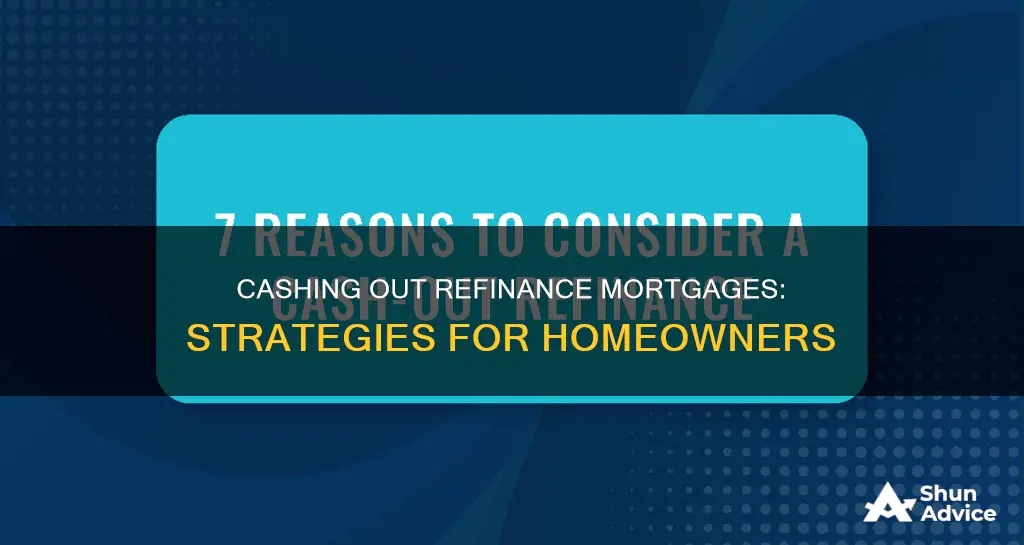
Cash-out refinancing is a way for homeowners to access cash by replacing their current mortgage with a new, larger loan. This allows them to convert their home equity into cash, which they can use for emergencies, debt consolidation, or large purchases. The new loan comes with different terms, including a new interest rate and loan term, and the borrower receives the remaining funds as a lump sum. While cash-out refinance rates tend to be higher than standard refinance rates, it can be a cheaper way to pay for large expenses and can help homeowners accomplish their home improvement goals.
| Characteristics | Values |
|---|---|
| Definition | A cash-out refinance is a mortgage refinancing option that allows borrowers to replace their current mortgage with a new, larger loan and receive the difference in cash. |
| Purpose | People can use the cash for various purposes, such as debt consolidation, home improvements, medical or educational fees, investments, or emergencies. |
| Eligibility | To qualify for a cash-out refinance, individuals typically need at least 20% equity in their home. Lenders assess the borrower's credit profile, debt, income, and loan-to-value (LTV) ratio to determine the approved loan amount. |
| Costs and Fees | Cash-out refinance closing costs typically range from 2% to 6% of the loan amount, including origination, title, appraisal, and credit report costs. |
| Interest Rates | Cash-out refinance rates tend to be higher than standard refinance rates, but borrowers may still get a lower interest rate if mortgage rates have dropped since their original loan. |
| Monthly Payments | A cash-out refinance usually results in higher monthly payments due to the larger loan amount. |
| Loan Balance | The new loan from a cash-out refinance will increase the borrower's loan balance. |
| Collateral | The borrower's home serves as collateral for the new loan, so there is a risk of losing the home if payments cannot be made. |
| Lender Considerations | Lenders take on increased risk with cash-out refinances, which may lead to higher closing costs, fees, or interest rates compared to standard refinances. |
| Types | Conventional cash-out refinances, FHA cash-out refinances, and VA loan cash-outs are some common types. |
What You'll Learn

Cash-out refinance requirements
Firstly, you must qualify for a higher loan amount. As you are taking out a new loan for more than you currently owe, your lender will need to verify your ability to afford a larger loan amount and higher monthly payment. You will need to have a sizable amount of equity built up in your home, and your lender will calculate your home equity by subtracting your loan balance from your home's appraised value.
Secondly, you will need to meet the credit score requirements. A credit score of at least 580 is usually required, and many lenders require higher credit scores for cash-out refinances. For example, a conventional loan will always require a minimum of 620, and a credit score of 600 is typically required for FHA loans.
Thirdly, you will need to meet the debt-to-income (DTI) ratio requirements. Most lenders prefer borrowers to have a DTI of 50% or lower, although it is possible to qualify with higher debt loads using FHA or VA loans.
Finally, you will need to pay for a home appraisal and closing costs, which typically range from 2% to 6% of your loan amount. You can pay these costs out of pocket or request that the lender deduct them from your payout.
It is important to note that cash-out refinance requirements are stricter than for a traditional refinance, and your monthly mortgage payment will likely increase.
Understanding Mortgages: A Guide to Home Loans
You may want to see also

Pros and cons of cash-out refinance
A cash-out refinance is a way to access cash by replacing your current mortgage with a new, larger loan. It is a popular process for replacing an existing mortgage with a new one that extends more favourable terms to the borrower. The new loan from a cash-out refinance may come with a different interest rate and loan term.
Pros of cash-out refinance
A cash-out refinance can be ideal if you qualify for a better interest rate than you currently have and plan to use the funds to improve your finances or your property. This could include upgrading your home to boost its value or consolidating high-interest debt to free up room in your budget. It is one of the cheaper ways to pay for large expenses, in part because the collateral involved—your home—translates to lower risk for lenders. With a cash-out refinance, you can get a considerable amount of money by unlocking home equity.
Cons of cash-out refinance
A cash-out refinance increases your debt burden and depletes your equity. It could also mean you’re paying your mortgage for longer. Cash-out refinance loans often have slightly higher interest rates than your standard rate and term refinance. Since you’re borrowing more money and reducing your equity, lenders may charge more for the additional risk. In addition, borrowing more money and extending your loan term can increase how much interest you pay over the life of your loan. You’ll incur the usual closing costs with a cash-out refinance, from origination and underwriting fees to title insurance and appraisal charges.
Strategies for Managing Multiple Mortgages and Financial Freedom
You may want to see also

How to calculate your cash-out refinance amount
A cash-out refinance allows you to convert your home's equity into cash. This is done by replacing your current mortgage with a new, larger loan. The funds from the new loan are used to pay off the old loan, and the remainder is paid to you in cash.
The amount of cash you can access depends on your home equity, or how much your home is worth compared to how much you owe. To calculate your home equity, subtract your loan balance from your home's appraised value. For example, if your home is worth $450,000 and you owe $300,000 on your existing mortgage, you have $150,000 in home equity.
Once you know your home equity, you can calculate your cash-out refinance amount. This will depend on the maximum loan-to-value (LTV) ratio allowed by your lender. The LTV ratio is the amount of your loan compared to the value of your home. For example, if your home is worth $450,000 and the maximum LTV ratio is 80%, then your maximum loan amount would be $360,000 ($450,000 x 0.80 = $360,000).
To calculate your cash-out refinance amount, subtract your current mortgage balance from the maximum loan amount. Continuing with the above example, if you subtract a mortgage balance of $300,000 from a maximum loan amount of $360,000, you could potentially cash out $60,000 ($360,000 - $300,000 = $60,000).
It's important to note that there may be closing costs and fees associated with a cash-out refinance, which can range from 2% to 6% of the loan amount. These costs can include origination fees, appraisal fees, credit check fees, and more. Additionally, a cash-out refinance may result in a higher monthly payment and a larger loan balance. Therefore, it's crucial to carefully consider your financial situation and ability to repay the loan before proceeding with a cash-out refinance.
Wall Street's Mortgage Business: How It Works
You may want to see also

Reasons for choosing a cash-out refinance
A cash-out refinance is a way to access cash by replacing your current mortgage with a new, larger loan. Here are some reasons why someone might choose to do this:
Lower Interest Rates
If mortgage rates have decreased since you bought your home, a cash-out refinance could be a good option. You can lock in a lower interest rate on your mortgage and access cash at the same time. This can be especially beneficial if you need funds for a large expense, such as home improvements, as you can secure a lower interest rate on a larger loan.
Debt Consolidation
A cash-out refinance can be used to consolidate high-interest debt, such as credit cards, personal loans, or auto loans. By doing so, you can reduce your overall monthly payments and the amount of interest you pay over time. This can help you better manage your debt and potentially improve your credit score.
Emergency Funds
Life is unpredictable, and sometimes we need access to cash for emergencies, such as medical expenses. A cash-out refinance allows you to tap into your home's equity and get a lump sum of cash when you need it most. This can provide financial peace of mind and help cover unexpected costs.
Major Purchases or Investments
A cash-out refinance can be a way to fund a major purchase or investment, such as starting a business, buying an investment property, or funding a college education. It can be a cheaper alternative to other forms of credit, as the loan is secured by your home, which translates to lower risk for lenders and potentially better terms for you.
It is important to carefully consider the pros and cons of a cash-out refinance, as it will result in a larger mortgage loan balance and potentially higher interest rates. Be sure to evaluate your financial situation and consult with a financial professional before making any decisions.
Verifying Primary Residence: What Mortgage Lenders Need to Know
You may want to see also

Cash-out refinance vs. home equity loan
A cash-out refinance is a way to access cash by replacing your current mortgage with a new, larger loan. The new loan pays off the old one, and you receive the difference in cash. The amount of cash you can access depends on your home equity, or how much your home is worth compared to how much you owe.
For example, if your home is worth $300,000 and you have $100,000 remaining on your loan, you have $200,000 in home equity. You can then take out a new mortgage loan of $300,000, pay off the old loan, and pocket the remaining $100,000.
A cash-out refinance can be a wise move if you need a large sum of money for a specific purpose, such as a major home improvement, debt consolidation, or an emergency fund. It can also be ideal if you intend to stay in your home for at least a year and can benefit from a lower interest rate, resulting in lower monthly payments. However, it's important to weigh the pros and cons before committing, as you will now be repaying a larger loan with different terms, including a new mortgage rate. Additionally, cash-out refinance rates tend to be higher than standard refinance rates, and you risk losing your home if you can't make the payments.
A home equity loan, on the other hand, is a separate loan from your original mortgage. It allows you to borrow against the equity you've built up in your property, but it won't replace your mortgage. Because it's a second loan, home equity loans typically have higher interest rates than first mortgages. They also come in two types: the traditional home equity loan, where you borrow a lump sum, and the home equity line of credit (HELOC), which is a revolving line of credit that you can access as needed.
Home equity loans can be a good option if you need a large lump sum of cash and have a lower mortgage rate than what you'd get with a new mortgage. They tend to have lower interest rates than personal, unsecured loans because they are collateralized by your property. However, it's important to note that the lender can come after your home if you default on the loan. Additionally, you may not qualify for a home equity loan if you have too much debt or poor credit.
In summary, a cash-out refinance can provide quick access to a large sum of cash by replacing your current mortgage with a new, larger loan. On the other hand, a home equity loan is a separate loan from your original mortgage and allows you to borrow against the equity in your home. Both options have their own advantages and disadvantages, and the best choice for you will depend on your financial situation and goals.
The Texas Mortgage Conundrum: How Do They Afford It?
You may want to see also
Frequently asked questions
A cash-out refinance mortgage is a way to access cash by replacing your current mortgage with a new, larger loan. It allows you to convert your home's equity into cash for emergencies, debt consolidation, or a major purchase.
The new mortgage pays off your previous, smaller mortgage balance, and you get paid the difference in cash. The new loan may come with a different interest rate and loan term.
A cash-out refinance can provide a large sum of cash at a lower interest rate than your original mortgage, especially if mortgage rates have dropped since you bought your property. It can also consolidate debt and eliminate the need for a second mortgage. However, cash-out refinance rates tend to be higher than standard refinance rates, and your monthly mortgage payments will likely increase.
The amount of cash you can receive depends on the value of your home, the amount you owe on your current mortgage, and the lender's maximum loan-to-value (LTV) ratio. Generally, you should have at least 20% equity in your home before refinancing.
People often use cash-out refinancing for large-scale home improvements, debt consolidation, education expenses, or starting a business.







